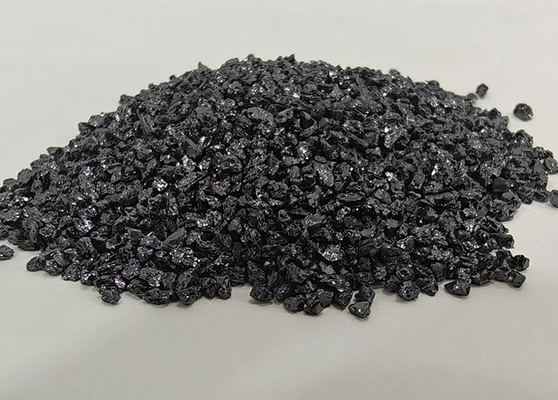Brown corundum cutting blades are common abrasive tools, widely used in cutting materials such as metal, stone, and concrete. Due to the hardness and wear resistance of brown corundum, cutting blades are usually used for high-intensity cutting operations. The process of making brown corundum cutting blades involves multiple steps, from the selection of raw materials to the quality inspection of the final product. The following is a detailed process for making brown corundum cutting blades:
Raw Material Preparation
Brown corundum grit: The hardness and wear resistance of brown corundum make it an ideal abrasive for cutting blades. We recommend using Chaoyan brand brown corundum grit . Chaoyan brand brown corundum grit can be customized according to the different requirements of the product. The particle size range used in the production of cutting blades is usually between F14 and F120.
Substrate: The substrate of the cutting blade is usually composed of fiber cloth, wire mesh, metal mesh and other materials to enhance the strength and toughness of the cutting blade. Common substrates include fiber cloth reinforced substrates and steel sheet reinforced substrates.
Binder: The binder usually uses resin (such as phenolic resin), metal binder or ceramic binder. Its main function is to firmly bind the brown corundum sand and the substrate to ensure that the cutting disc will not break during use. Resin binder is the most widely used.
Additives: In order to improve the performance of the cutting disc, some specific chemical additives may also be added, such as hardeners, antioxidants, anti-wear agents, etc.
Brown Corundum Sand Screening and Mixing
Screening: The brown corundum sand is screened to ensure that the particles are uniform and meet the designed particle size requirements. Too large or too small particles will affect the effect of the cutting disc.
Mixing: Mix the brown corundum sand, binder and other additives in the specified proportion. When mixing, it is necessary to ensure that the sand and binder are completely and evenly combined to avoid uneven distribution of sand affecting the cutting effect.
Coating and Pressing
Substrate coating: Apply the mixed sand and binder to the substrate surface of the cutting disc. The substrate is usually made of fiber cloth or metal mesh. The purpose of coating is to enhance the structural strength of the cutting disc.
Pressing: Put the coated substrate and mixture into the mold for pressing. The material is compacted under high pressure to ensure that the sand particles are evenly distributed and tightly adhere to the substrate. This process is usually completed using a hydraulic press, and the pressure needs to be properly adjusted to avoid cracking the substrate due to over-pressing.
Drying and Curing
Drying: The pressed cutting disc needs to be dried to remove excess water and solvent. Drying is usually carried out at low temperatures to avoid damage to the substrate and adhesive caused by high temperatures.
Curing: For cutting discs using resin-based adhesives, curing is also required after drying. Curing is to completely harden the adhesive by heating to ensure the durability and structural stability of the cutting disc. The curing temperature is usually between 150°C and 180°C, and the curing time varies depending on the specifications of the product and the type of adhesive.
Cooling and Demoulding
Cooling: The cured cutting disc needs to be cooled naturally to room temperature. During the cooling process, ensure that the temperature is gradually reduced to avoid cracks in the cutting disc due to excessive thermal stress.
Demolding: The cooled cutting disc is removed from the mold. At this time, the appearance and structure of the cutting disc need to be carefully checked to ensure that there are no cracks, defects or sand particles falling off.
Trimming and Cutting
Trimming: After the cutting disc is removed from the mold, the edges are usually uneven and need to be trimmed. The trimming process includes grinding the outer edge of the cutting disc with a grinder or trimmer to ensure the flatness and appearance of the cutting disc.
Cutting to specification: Cutting is performed according to the final specifications of the cutting disc (such as diameter, thickness, etc.). Laser cutting, laser drilling and other precision processing methods are usually used to ensure that the size of the cutting disc meets the requirements.
Quality Inspection
Appearance inspection: Check the appearance of the cutting disc to ensure that there are no problems such as cracks, deformation or sand shedding.
Hardness test: Use a hardness tester to test the hardness of the cutting disc to ensure that it has sufficient hardness to cope with the cutting task.
Wear test: Test the wear resistance of the cutting disc through experiments to ensure its durability during use.
Balance check: The cutting disc needs to have good balance to avoid vibration during use. Professional balance test instruments are usually used to check the balance of the cutting disc.
Impact test: Check the impact resistance of the cutting disc to ensure that it is not easy to break during high-speed cutting.
Packaging and Storage
Packaging: Qualified cutting discs will be packaged according to customer requirements. Common packaging methods include plastic bags, cartons or wooden boxes to prevent damage during transportation.
Storage: Cutting discs need to be stored in a dry and ventilated place to avoid humidity, high temperature and other environments that affect their quality. In particular, cutting discs with resin binders should be avoided from being stored in direct sunlight or humid environments for a long time to avoid affecting the stability of the binder.
Summary
The production process of brown corundum cutting discs includes multiple links such as raw material selection, mixing, coating, pressing, curing, trimming, quality inspection, etc. Each link is crucial, and negligence in any link may affect the performance and service life of the final cutting disc. Therefore, strict process control and quality inspection are the key to ensuring the efficient, stable and safe use of brown corundum cutting discs.
Request a Quote or Sample
Popular Products
Grünes Siliziumkarbid
View DetailsSchwarzes Siliziumkarbid
View Details